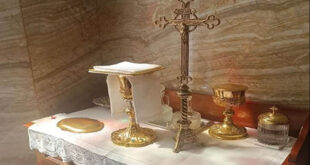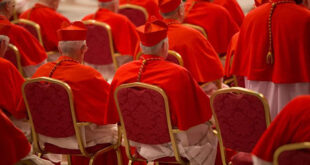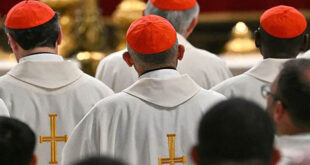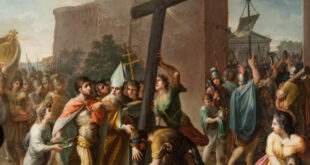At the heart of Holy Week, as the Catholic Church immerses itself in the contemplation of the deepest mysteries of the faith, Holy Thursday emerges as a day of special solemnity. Among the rites that mark this day, one of the most symbolic and moving is the washing of the altar. This seemingly simple gesture is a profound expression of humility, purification, and love, inviting us to reflect on the meaning of the liturgy and our relationship with God. In this article, we will explore the origin, history, theological significance, and current practice of this ritual, with particular attention to how it is carried out in St. Peter’s Basilica in the Vatican.
Origin and Historical Significance of the Washing of the Altar
The washing of the altar on Holy Thursday has its roots in the ancient liturgical tradition of the Church. This ritual dates back at least to the 7th century, when it began to be practiced in Rome as part of the preparations for the celebration of Easter. At that time, the altar was not merely a sacred piece of furniture but a symbol of Christ Himself, the “cornerstone” of the faith (Ephesians 2:20). Therefore, its cleansing took on a deep spiritual meaning: it was an act of reverence toward the Lord, who offered Himself in sacrifice for the salvation of the world.
The ritual became more established in the Middle Ages, when the Church emphasized the importance of ritual purity and the preparation of the heart to receive the sacred mysteries. The washing of the altar was associated with the washing of the feet, which Jesus performed for His disciples before the Last Supper (John 13:1-17). Both gestures express the same idea: the humble service and selfless love that should characterize Christ’s followers.
The Theological Meaning: Purification and Renewal
The washing of the altar is not merely an act of physical cleaning but a symbol rich in theological meaning. First, it represents the purification of the heart, which must be free from sin to welcome Christ in the Eucharist. Water, the central element of the ritual, is a sign of life, grace, and renewal, reminding us of baptism and the constant need for conversion.
Furthermore, the altar, as the place where the Eucharistic sacrifice is offered, is an image of Christ, the “Lamb of God who takes away the sin of the world” (John 1:29). By washing it, the Church acknowledges the holiness of this space and renews its commitment to worship God with a pure heart. This gesture also invites us to reflect on our own vocation: we are called to be “living altars,” offering our lives as a spiritual sacrifice pleasing to God (Romans 12:1).
The Washing of the Altar in St. Peter’s Basilica: A Ritual Full of Solemnity
In St. Peter’s Basilica, the washing of the altar is a moment of great solemnity and liturgical beauty. The ritual takes place after the Mass of the Lord’s Supper, when the Blessed Sacrament has been transferred to the altar of repose, a specially prepared space for Eucharistic adoration during the Paschal Triduum.
The rite begins with the chanting of antiphons and psalms that evoke God’s mercy and the purity of the heart. The deacons, vested in white dalmatics, approach the altar with jugs of water and sponges. The water, previously blessed, is poured over the altar while prayers are recited, invoking the purification of the Church and all the faithful. This moment is particularly moving, as the sound of the water falling on the stone altar resonates in the silence of the basilica, creating an atmosphere of recollection and prayer.
One of the most interesting details of this ritual in the Vatican is the use of special water, mixed with wine, which symbolizes the blood of Christ shed for the salvation of the world. This gesture reminds us that the altar is not only a place of sacrifice but also of life and redemption.
The Washing of the Altar in the Modern Context: A Call to Humility and Service
In a world marked by haste, individualism, and the pursuit of power, the washing of the altar on Holy Thursday offers us a profoundly relevant message: true leadership is exercised through humility and service. This ritual invites us to imitate Christ, who “did not come to be served, but to serve” (Mark 10:45), and to remember that the greatness of the Church lies not in its temporal power but in its ability to love and serve those most in need.
Moreover, in a time when purity and moral integrity are often questioned, the washing of the altar reminds us of the importance of living with coherence and transparency, both in our personal lives and in our ecclesial community. This gesture challenges us to examine our conscience and to ask God to purify us from all sin, so that we may be authentic witnesses of His love in the world.
A Historical Anecdote: The Altar and the Martyrs
An interesting fact that few know is that many ancient altars, including that of St. Peter’s Basilica, contain relics of martyrs. This tradition dates back to the early centuries of Christianity, when the faithful celebrated the Eucharist over the tombs of martyrs, who were considered heroic witnesses of the faith. The washing of the altar, therefore, not only purifies the sacred space but also honors the memory of those who gave their lives for Christ. This detail reminds us that our faith is built on the testimony of countless men and women who knew how to live the Gospel to the fullest.
Conclusion: A Gesture That Unites Us to the Mystery of Christ
The washing of the altar on Holy Thursday is much more than a liturgical ritual; it is an invitation to deepen our understanding of the mystery of Christ and to renew our commitment to follow Him faithfully. This gesture, which unites heaven and earth, reminds us that true worship does not consist of external rites but of the sincere offering of the heart.
This Holy Thursday, as we contemplate the altar being washed, let us ask the Lord to purify our lives and grant us the grace to be, like Him, humble and loving servants. May this ritual inspire us to live our faith authentically, bringing Christ’s love to every corner of the world. In this way, the washing of the altar will not be merely a liturgical act but a true encounter with the God who loves us and calls us to be holy.






